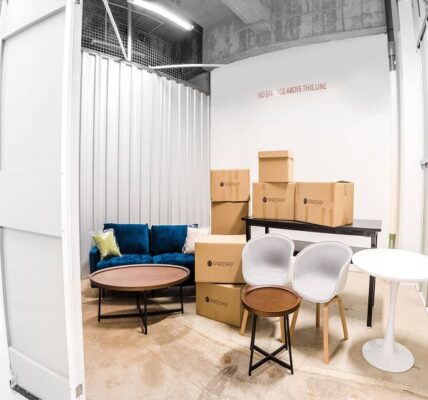When transporting stored material from point A to point B by warehousemen, forklifts or ground vehicles, every movement stirs up dust. The constant suction serves, on the one hand, for safety and cleanliness, but also ensures that the stored material is preserved and does not collect dust. Scraps of paper from torn labels or transport documents, pieces of film or splinters of wood can also often be found in warehouses. Dust, lint and small bits of paper can be easily removed with a broom, sweeper or vacuum cleaner – depending on the size of the warehouse. This factor is very important when choosing suitable devices and cleaning concepts.
Especially in warehouses, due to the increased problem of dust, a sweeper is preferable to a simple mechanical sweeper: during the sweeping process, the sweeper swirls the dust with a roller brush, sucks up the dirt with the help of a suction turbine (blower) and separates it with a filter system – the amount of dust is therefore reduced during cleaning. Regular cleaning of the fine particle filter can considerably increase its service life. Depending on the type of machine, this is done by simply pressing a button or automatically.
In addition to dust and scraps of paper, warehouse floors are often littered with scrap film and packing tape or splinters of wood from pallets. This coarse dirt must be removed manually, otherwise there is a risk of clogging of the machines used or of material getting stuck in the broom roller. Cleaning can be done with a broom or a tweezer.
In order to work with as little dust as possible, there is a perfectly fitting cover made of PVC-coated linen fabric. The latter is stretched with a system of hook-and-loop strips over the entire front area of the sweeper up to the rear wheels. This accessory makes it possible to limit the whirlwind of dust.
Spot cleaning in the warehouse
For small intermediate cleaning jobs – on the floor as well as on shelves or storage surfaces – a suitably sized wet and dry vacuum cleaner, flexible and quick to handle, is particularly suitable in very small storage spaces. This means that dust, puddles or spilled liquids can be vacuumed up quickly and easily. In the case of very small storage racks, manual equipment consisting of wipes and buckets can also be used.
First of all, it is important to take into account the type of soil. Ceramic tiles such as fine porcelain stoneware are often laid in small workshop warehouses because they are sturdy and have very low moisture absorption capacity. Company warehouses or logistics centers are often equipped with industrial floors – from screed to elastic synthetic coatings such as synthetic resin.
Since warehouse floors can be very varied, there is also great diversity in choosing the right cleaning technique. The configuration of the floor and the types of dirt in the warehouse are two of the main criteria. Due to the amount of coarse dirt, scrubber driers with roller technology are particularly suitable, as the remaining coarse dirt can be picked up in one operation thanks to the preventive function of the rollers.
Fine porcelain stoneware is a pleasant and very popular floor covering, which is characterized by its robustness, its non-slip properties and its very low rate of moisture absorption. Today, fine porcelain stoneware has become a modern and safe design element in the field of flooring.
Cement screed is the most common type of screed. This flooring requires special care when cleaning and maintaining it. Because it is extremely abused and at the same time has to meet the occupational safety requirements in the company. Whether for routine cleaning, maintenance or make-up, it is important to choose the right equipment.
The choice of the right mechanism (roller or disc) and the right cleaning tool (pad or brush) depends on the floor covering and the type of dirt.
If the soil permits, an alkaline detergent is usually used. If acid detergents are used, care should be taken to wet the cement joints with water beforehand so as not to damage them.
Especially in warehouses, care should be taken to ensure that scrubber driers leave the floor dry. This is particularly important because the cleaned areas are often walked on immediately or used by forklifts – and occupational safety is essential.
Combined machines for very large warehouses: sweeping, washing and vacuuming with one machine
A combined machine is recommended for very large warehouses with an area of more than 10,000 m². Machines with dust extraction and a filter area of up to 10 m² should be used there. These devices sweep, scrub and vacuum in one step, saving time and increasing productivity, especially on large areas. The models with side brushes in particular also pick up loose dirt from the wall.
A distinction should be made between devices that have a pre-mounted sweeping unit and thus dry clean the floor before the downstream roller brush takes over the wet brushing.
These models work with a separate broom roller and offer a very good cleaning result. However, due to the prevention module, they have a large overall length (relatively large turning radius between the drive gears), and dry cleaning allows more dust to be blown off. For this, the collected dirt can be emptied easily and dry.
Machines with large roller brush head for sweeping and brushing
In the case of devices with an integrated sweeping function, one generally speaks of a large roller brush head. However, here the dirt is swept up by a roller diameter 2.5 times larger and usually thrown into a large container for high emptying. These devices can both sweep automatically in washing mode and dry without water with a filter system.





